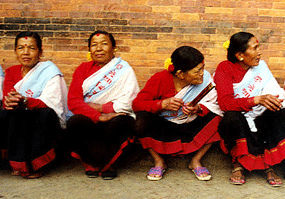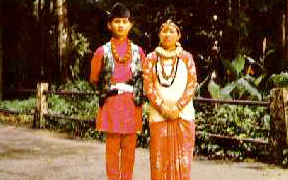|
|
|
One of the greatest assets of the Nepal is its people. These people resides in the mountains, hills, the lower hills or the Terai and the great plains of Nepal. Over the last century, there has been a move in population from west to east, and a continuous flow into India. Over 40% of the population live in the Terai, 56% in the central region and 5% in the Kathmandu Valley. Hindi, Nepali and Mailthali are widely spoken in the Terai. More than 6 million Nepalis live in the Indian states of Bihar, West Bengal and Assam. The Nepalis are known for their honesty, hospitality and their ability to grin and bear whatever the situations are. Interwined into this fine tapestry of more than 112 different indigenous, ethnic and sub-class groups, are the modern immigrants to Nepal, people from Tibet, Bhutan, the erstwhile kingdom of Sikkim, Darjeeling and the north-eastern states of India.
|
|
|
|
Social origins
|
|
The Tamang, Rai, Limbu, Bhote and Sunwar are the main tribals of Tibetan origin who resides in the centre and east, while the Magar and Gurung lives in the west. High caste Brahmins, Thakuris and Chettris dominate the Hindu social system. They speak Nepali language and are closely related to the dominant communities of northern India. Today, Hindus make up 90% of Nepal’s population. The Mongoloid people have entered into the country from the Tibetan plateau in the north and comprises of 20% of the people of Nepal. While from south, the Indo-Aryan people have entered into the country, who comprises 80% of the total population of Nepal. |
|
|
|
|
Newars |
|
The Newars belongs to Mongolia and have settled in the Kathmandu Valley for over 2000 years. They have absorbed many Indian characteristics, including Hinduism. The majority of the Newars are Saivite Hindus, while some of them are Buddhists. They speak the Newari language which is commonly placed in the Tibeto- Burman family, and influenced by both Tibeto-Burman and Indo-European languages. Despite losing political power in the mid 18th century, Newaris still follow their identity, language and rituals that are combination of Hinduism, Buddhism and Animism. The Newars are the creators of the three separate cities of Bhaktapur, Lalitpur and Kathmandu that join
together to make the modern capital of Nepal. |
 |
|
The Newars believes that the goddess Kumari temporarily resides in the bodies of the Newar Buddhist girls.
Nearly a dozen communities have Kumaris, and each is worshipped with offerings of ornaments, food and money. Most of the girls give up this holy post on reaching puberty, although, recently the Kumari of Patan retained her post till the age of twenty. Since her feet were literally not allowed to touch the ground, a relative carried her around. The Newars also believes that the Kathmandu Valley was a deep lake until the Boddhisatva Manjusri swung his mighty sword to create a huge cleft in the encircling mountains. The Newars were the Nepal’s leading traders, who organize the trains of basket carrying porters over the trans-Himalayan passes to Tibet. The Newars are also the remarkable craftsmen. They developed the country’s unique building style that successfully blends influences from India, China and Tibet, with carved wood beams and pagoda-like temple roofs. The skillfully built temples and palaces, delicately engraved stone and metal images, carved wooden columns and pillars and the history laden shrines and stupas stands as testimony to the artistic achievements of the
Newars. |
|
|
|
|
|
Indo-Nepalese |
 |
The Indo-Nepalese groups comprises the 80% of the population and consists of the people of the Terai, Paharis (Hill people) and Tharus. There was also considerable early Buddhist influence, although the Lamaistic Buddhism that entered Nepal from the N was quite different. The Tharus are believed to be the descendants of some of the original inhabitants of the Terai and are distributed along Lumbini, just inside the Nepal's border with India. There are about 800,000 Thaurus who are farmers and generally practice a form of Hinduism that is mixed with animist beliefs. |
|
|
|
|
Tibeto-Nepalese |
|
The Tibeto-Nepalese groups include the Gurung, Magar, Rai and Tamang which have contributed towards the famous Gurkha regiments of the British army. The Gurungs live in the shadow of the great Annapurna mountain, and are known for their strength, endurance and fearlessness. As early as the 16th century they were much sought after by Indian princes and in the late 18th century formed the martial stock which created the Gurkha kingdom. In the 19th century, these groups were largely placed in the British army. The word Gurkha is a geographical term that refers to the Gurung, who came from the fortress town of Goraknath. There are about 300,000 Gurungs who depend strongly on the military as a source of income. Gurkhas have played distinctive and gallant roles in British wars and campaigns since 1815. The Gurkhas have won 26 Victoria Crosses for gallantry and various other battle honours and are regarded as an intrinsic and loyal element in British army. Some villages derive over 75% of their income from military service and are dependent on it. The Magars and Rais are very large groups, and are placed in the Gurkha regiments. Most of them are subsistence farmers who lives in the middle Zone hill country of Western and Central Nepal from the high mountain down to the Terai. They all have Mongoloid features. The Tamangs believes that the first mother of the Tamangs was a cow who bore 3 sons, the youngest of whom, Tolgu, founded the race. The Tamangs practise a religion which looks like Tibetan Buddhism blended with Hindu teachings and also incorporate elements of their ‘old’ religion based on shamanism. They live just beyond the Newari-Hindu cultural area of the Kathmandu valley. Most of the Tamangs are subsistence farmers, but their name describes that they were the horse traders and similar to the
Sherpas. |
|
|
|
|
Thakalis |
|
The Thakalis originates from the Kali Gandaki gorge and are influenced by both Hinduism and Buddhism. They have established little hotels all along the Annapurna Circuit and extended their influence as hoteliers to other parts of the country. There are only about 10,000 Thakalis and were the subsistence farmers, before Nepal was opened up to tourists. |
|
|
|
|
Bhotiyas |
|
The Bhotiyas lives in the northern part of Bhutan, Sikkim, Nepal and along the Indo-Tibetan border in Garhwal, Kumaon and Himachal Pradesh. They are Mongolian who gradually moved off from the Tibetan plateau. They include the world renowned Sherpas, who immigrated from Tibet about 600 years ago. The word Sha means east, pa means people. Earlier, the Sherpas were traders and porters, who carried butter, meat, rice, sugar, paper and dye from India, and salt, wool, jewellery, Chinese silk and porcelain from Tibet and beyond. The Sherpas live in the Solu Khumbu region of glacial valleys at the southern approaches to Everest. Due to the close of the border following the 1962 war between India and China, their economy was undermined. Due to various mountaineering expeditions and trekkers, the Sherpas found their load carrying skills, both on normal treks and at high altitudes, in great demand. The Sherpas also received considerable help to set up schools and small hospitals. The foundation is named after Edmund Hillary, the first European who reached the top of Everst and felt that he had a debt to repay the
Sherpas. |
|
|
|
|
|
|

